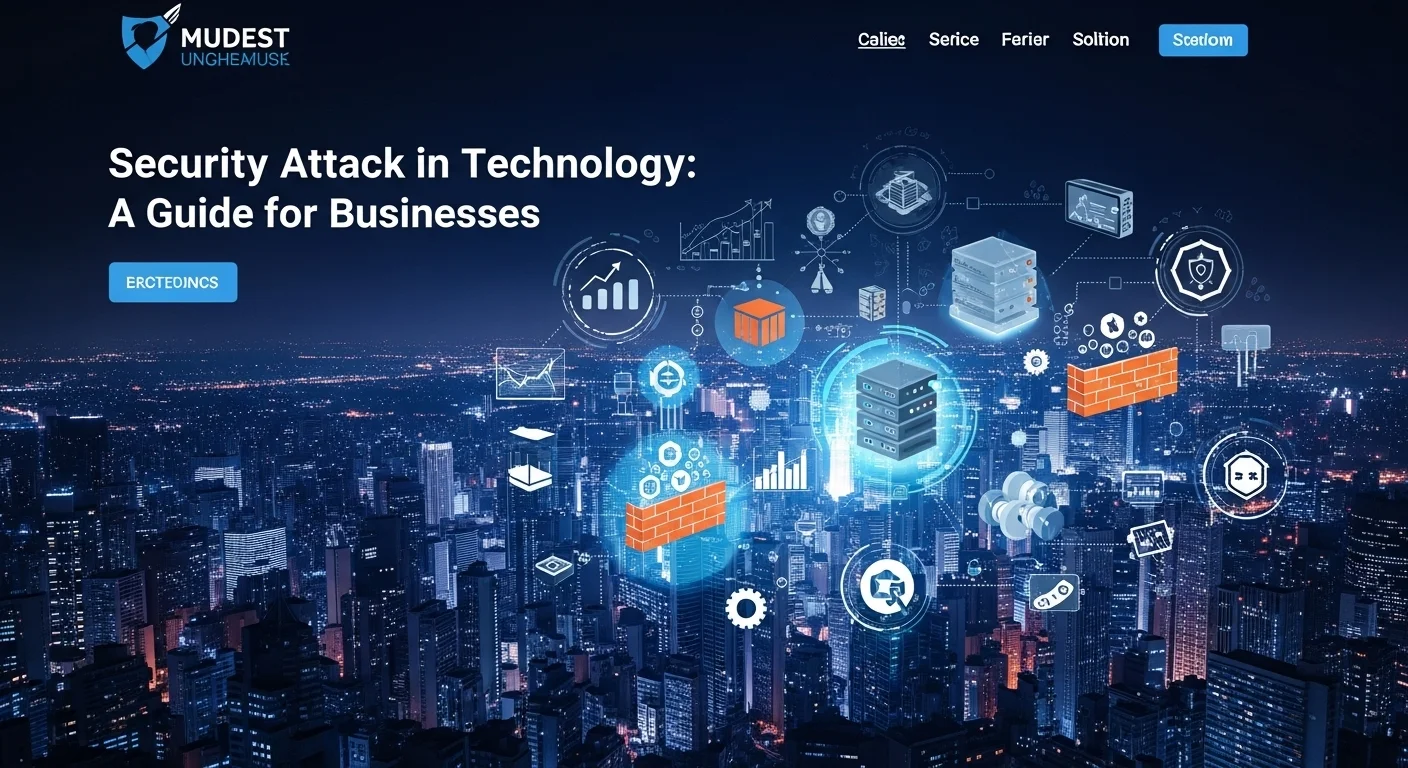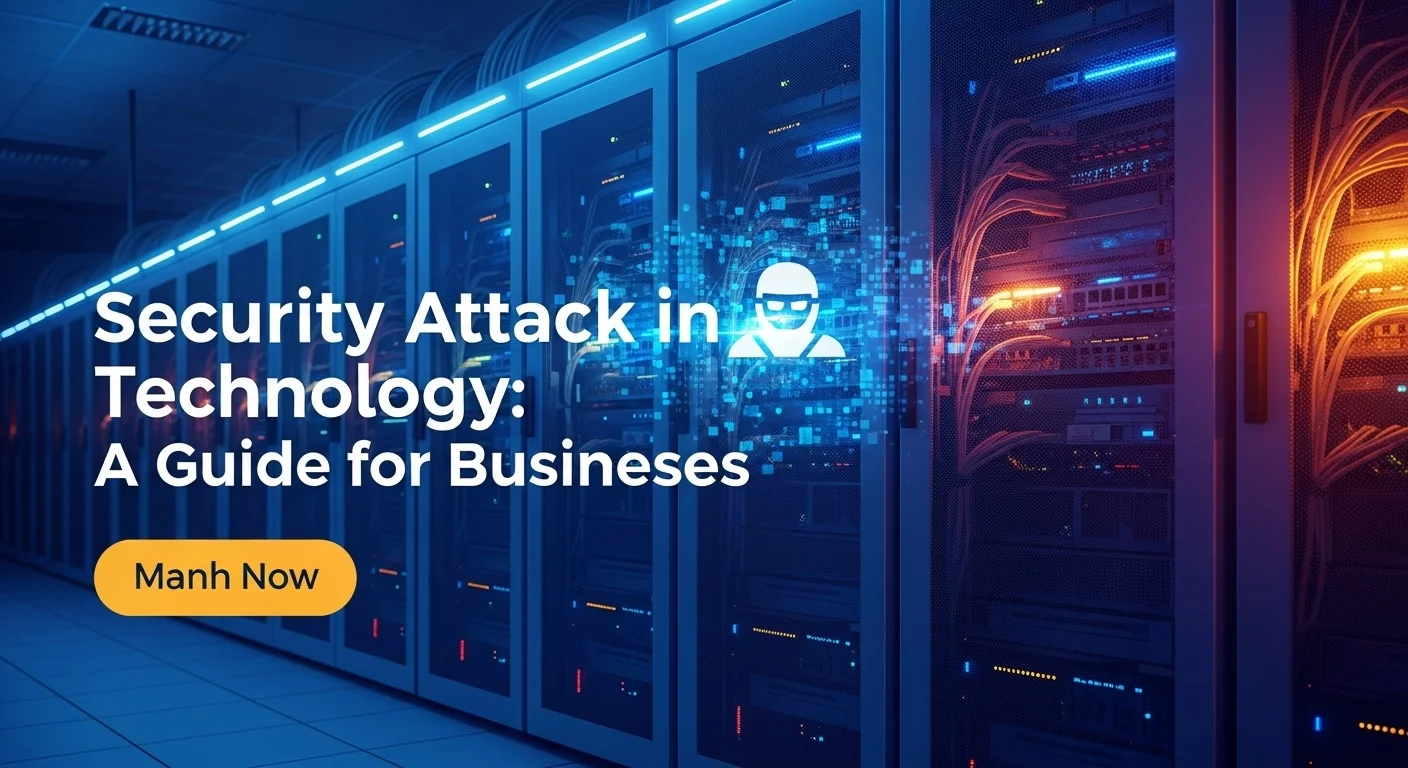Cybersecurity Threats Explained: A Real-World Guide to Protecting Your Business

Executive Summary
After more than a decade in the cybersecurity trenches, I've seen firsthand how a single security attack can cripple a thriving business. It's not just about faceless hackers in dark rooms; it's about protecting your livelihood. A security attack is simply any unauthorized attempt to mess with your technology—to steal data, cause chaos, or shut you down. This guide is my way of cutting through the jargon. We'll walk through the real-world threats businesses like yours face every day, from attacks on your network and the APIs that run your apps, to the surprising danger of an unhappy employee, and even the risk of someone just walking out with a laptop. My goal is to give you the foundational knowledge to see these threats coming and build a solid defense. Consider this your first step toward creating a truly resilient business that can stand strong in today's digital world.
Table of Contents
Table of Contents
- What Exactly is a Security Attack and Why Does It Matter?
- Understanding the Landscape of Cyber Threats
- The Business Imperative for Strong Security
- A Deeper Look at Attack Methods
- Business Techniques and Resources for Defense
- Actionable Tips to Improve Your Security Experience
- Essential Business Tools and Tech Experiences
- Embracing the Future: AI in Cybersecurity
What Exactly is a Security Attack and Why Does It Matter?
In my line of work, the term 'security attack' comes up a lot, but let's break down what it really means for you. At its heart, a security attack is any intentional act aimed at compromising your digital world. Think of it like someone trying to break into your office. They might want to read your private files (a breach of confidentiality), change your financial records (a breach of integrity), or lock the doors so you can't get in to work (a breach of availability). Protecting against these attacks is non-negotiable because the fallout can range from a major headache to a business-ending disaster.
Technology has given us amazing tools, but every new app, device, or employee with network access is like adding a new door or window to your office—another potential way for someone to get in. That’s why thinking about security isn't just a job for the IT department; it’s a fundamental business responsibility. The people behind these attacks have all sorts of motives, from making a quick buck with ransomware to corporate espionage or just pure mischief. To truly protect ourselves, we first have to understand what we're up against.
Understanding the Landscape of Cyber Threats
Security attacks aren't a monolith; they come in different flavors. A foundational threat is a network security attack. Imagine your network as the building's plumbing. An attack here could poison the water supply or just shut it off entirely. A common example is a Distributed Denial-of-Service (DDoS) attack, where attackers flood your website with so much junk traffic that real customers can't get through. Another sneaky one is a Man-in-the-Middle (MitM) attack, where a hacker secretly places themselves between you and a service you're using, listening in on everything, kind of like a digital wiretap.
As our technology gets more connected, new weak spots appear. I've seen a huge rise in API attacks lately. APIs (Application Programming Interfaces) are the messengers that let different software talk to each other. They're essential for modern apps, but if they're not secure, they can be a wide-open door for attackers. The OWASP API Security Top 10 is a great resource that points out common flaws, like an attacker figuring out they can view someone else's invoice just by changing a number in the web address. It sounds simple, but it happens all the time.
We often fixate on threats from the outside, but some of the most damaging incidents I’ve dealt with came from within. This is what we call an internal attack in cyber security, or an insider threat. It could be a disgruntled employee deliberately stealing client lists or an honest mistake by someone who clicked on a phishing email. These are especially tricky because the person already has the keys to the kingdom, making it much harder to spot their malicious activity. It really drives home the need for a 'Zero Trust' mindset, where you don't automatically trust anyone, even if they're inside your network.
Finally, we can't forget the physical world. A physical attack is a direct, hands-on threat to your hardware. I've seen cases of laptops being stolen from cars, attackers tailgating employees through secure doors, or even finding sensitive documents in the trash. All the best digital security in the world means nothing if an attacker can just pick up your server and walk away with it. A truly complete security plan has to include locked doors, surveillance cameras, and secure ways to get rid of old equipment.
The Business Imperative for Strong Security
For any business, the consequences of a security breach are serious. The most obvious is the financial hit, from stolen funds to paying a hefty ransom. But in my experience, the indirect costs are what really hurt. You have to pay for experts to clean up the mess, you could face massive fines for data breaches under laws like GDPR, and you might get sued by angry customers.
Beyond the money, the damage to your reputation can be catastrophic. Trust is hard to earn and easy to lose. If your customers feel you can't protect their data, they'll go to your competitor who can. The operational disruption alone can be crippling. Imagine your e-commerce site being down for a week or losing access to all your critical files. That's not just lost revenue; it's a potential death blow to your business operations.
Today's businesses run on complex systems—cloud services, AI, and countless interconnected apps. This has massively expanded the 'attack surface,' or the number of potential entry points. An API attack could cause a domino effect, taking down multiple services at once. The shift to remote work means an attack on your computer network security is no longer just about the office; it's about protecting every employee's home network. This complex new reality demands a sophisticated, layered security plan that covers every angle, from the physical data center to an employee's laptop. This comprehensive view is the bedrock of a successful, resilient modern business.

A Deeper Look at Attack Methods
To build a solid defense, you need to understand how the offense plays. Security isn't a one-time purchase; it's a constant process of managing risk and responding to threats. I always tell my clients that the best defense is built in layers, so if one fails, another is there to catch the attacker. Let's break down the technical side of these attacks and the practical business solutions you can use to stop them.
Technical Deep Dive into Attack Methodologies
Here’s a closer look at the mechanics behind the most common attacks I see in the field. Knowing these details is the key to choosing the right defenses.
1. Network Security Attack: Threats to Your Digital Foundation
A network security attack goes after the very channels your business uses to communicate. A classic example is the DDoS attack. Let me simplify the three main types:
- Volumetric Attacks: Imagine a thousand people trying to cram through a single doorway at once. That's a volumetric attack. It uses a firehose of junk traffic to clog your internet connection so no legitimate customers can get in.
- Protocol Attacks: This is a craftier approach. Instead of just brute force, it exploits the rules of internet communication. A SYN flood, for example, is like knocking on a server's door thousands of times a second and running away. The server keeps waiting for you to finish the handshake, quickly gets overwhelmed, and can't answer the door for anyone else.
- Application Layer Attacks: These are the most sophisticated. They target the applications you run, like your website. An HTTP flood sends what looks like legitimate requests from real users, making it much harder to detect. It’s like having a small group of people repeatedly ask your receptionist incredibly complex questions, tying them up so they can't help real customers.
Another common tactic is the Man-in-the-Middle (MitM) attack. Here, an attacker secretly places themself between two people who think they're talking directly—for instance, between your employee and your company's Wi-Fi. If the connection isn't properly encrypted, the attacker can read, and even change, everything being sent back and forth, from passwords to financial data.
2. API Attack: The Modern App's Achilles' Heel
With today's apps relying heavily on microservices, APIs have become a huge target. I've seen an API attack bring a company's entire operation to a halt. The OWASP API Security Top 10 is the go-to guide here:
- API1:2023 - Broken Object Level Authorization (BOLA): This is the most frequent API flaw I encounter. It's when an attacker realizes they can access someone else's data by simply changing an ID in a web request, like changing `.../invoices/123` to `.../invoices/124`. The server fails to check if the user is actually allowed to see invoice #124.
- API2:2023 - Broken Authentication: This covers all sorts of login weaknesses. Attackers might exploit a system that doesn't properly check digital tokens (JWTs) or simply try using lists of passwords stolen from other websites, hoping your users reused them.
- API5:2023 - Broken Function Level Authorization: This is when a regular user can access administrative functions. For example, they might discover an endpoint like `/api/admin/deleteUser` that was left exposed without checking if the user is actually an admin.
3. Internal Attack in Cyber Security: The Threat from Within
An internal attack is tough because it bypasses all your perimeter defenses. The attacker is already inside. Some technical methods they use include:
- Privilege Escalation: An employee with basic access finds a flaw to grant themselves admin rights. Once they have that, they can do almost anything.
- Data Exfiltration: This is just a fancy term for data theft. I've seen insiders use everything from USB drives to their personal email to sneak sensitive files out of the company.
- System Sabotage: A disgruntled employee might delete crucial data or plant a 'logic bomb'—malicious code that's timed to go off later, maybe right after they've quit.
4. Physical Attack: Where Digital and Real Worlds Collide
Your physical security plan needs to account for direct threats to your hardware. Common techniques include:
- Tailgating: An attacker simply follows an authorized employee through a secure door. It sounds simple, but it works.
- Hardware Theft: Laptops and servers get stolen. If the data on them isn't encrypted, it's game over for that data.
- USB Dropping: An attacker leaves an infected USB drive labeled 'Payroll Info' in the parking lot. Curiosity gets the better of an employee, they plug it in, and malware is installed.
Business Techniques and Resources for Defense
Defending against these threats requires a smart mix of technology, clear rules, and well-trained people.
For Network Security:
- Technology: Use modern firewalls (NGFWs) and Intrusion Prevention Systems (IPS) as your first line of defense. A Web Application Firewall (WAF) is essential to protect your web-based services. For DDoS, you really need a specialized service that can absorb the attack for you.
- Policy: Be strict about who can connect to your network (NAC). And insist on VPNs for all remote work—it's like putting all remote traffic inside an armored car.
For API Security:
- Technology: An API Gateway is a must. It acts as a single, heavily-guarded checkpoint for all your API traffic, enforcing security rules and logging everything. Regular code scanning during development is also key to catching flaws early.
- Policy: Build security into your development process from day one. Mandate strong authentication for all APIs and, I can't stress this enough, check authorization on every single request.
For Internal Threats:
- Technology: User Behavior Analytics (UEBA) systems are fantastic. They use AI to learn what's normal for your users and flag weird behavior, like an accountant suddenly trying to access engineering files at 3 AM. Data Loss Prevention (DLP) tools can stop sensitive data from leaving your network.
- Policy: The Principle of Least Privilege is your best friend. Give people access only to what they absolutely need to do their job. Adopt a Zero Trust mindset: never trust, always verify. And have a rock-solid process for when an employee leaves to ensure all their access is cut off immediately.
For Physical Security:
- Technology: Use multi-factor access for sensitive areas like server rooms (e.g., a card swipe and a PIN). Install cameras. And encrypt the hard drives on all your laptops and servers.
- Policy: Have clear rules for visitors and train your staff to be your eyes and ears. Everyone should feel empowered to politely challenge someone they don't recognize who isn't wearing an ID. Also, have a professional service shred and destroy old hardware.
By layering these approaches, you create a security posture that is tough to break. A WAF might stop an attack from the internet, but it won't stop a malicious insider. Encryption protects a stolen laptop, but it won't stop a vulnerable API from leaking data. You need it all working together to effectively manage the risks in today's tech landscape.

Actionable Tips to Improve Your Security Experience
Let's move from theory to action. This is about making your technology experience not just more innovative, but fundamentally safer and more trustworthy. A truly resilient business is built on a combination of the right tools, a security-aware culture, and a commitment to always be learning. By implementing these strategies, you can dramatically lower your risk and be ready to act when an incident eventually happens.
Best Practices for Building a Resilient Organization
A strong security posture isn't a project; it's a culture. It has to be built from the ground up, with everyone playing a part.
1. Your People Are Your Best Defense
I've seen multi-million dollar security systems bypassed by a single, well-crafted phishing email. Your 'human firewall' is your most critical asset.
- Ongoing Training, Not Once-a-Year Drudgery: Ditch the boring annual training. Run regular phishing simulations to see who's still clicking. Send out quick security tips via email. Make it relevant—train your developers on secure coding to prevent that nasty API attack, and train your finance team to spot fraudulent wire transfer requests.
- Get Leadership on Board: Security has to start at the top. When your CEO takes security seriously, everyone else does too. It needs to be a regular topic in leadership meetings, not an afterthought.
- Celebrate the Wins: I always encourage companies to reward employees who spot and report something suspicious. It creates a positive, proactive culture where people feel like part of the solution, not a liability.
2. Build a Layered Defense (The Castle Approach)
I like to explain this using a castle analogy. You don't just have one big wall. You have a moat, high walls, guards, and a locked vault for the crown jewels. Your security should be the same.
- The Moat (Perimeter Security): This is your firewall and intrusion detection systems. It's your first defense against a broad network security attack from the outside world.
- The Walls (Endpoint Security): Every single device—laptop, server, phone—needs its own protection. This means modern antivirus (NGAV) and endpoint detection and response (EDR) tools that can spot sophisticated threats.
- The Guards (Application Security): Protect the apps themselves with secure coding, regular vulnerability scanning, and a Web Application Firewall (WAF). This is your key defense against a targeted API attack.
- The Vault (Data Security): The data is your treasure. Protect it with encryption, both when it's stored and when it's moving. Data Loss Prevention (DLP) tools can prevent it from being snuck out. This is your last line of defense; even if an attacker gets in, encrypted data is just gibberish to them.
- The Foundation (Physical Security): Don't forget the ground your castle is built on. A strong defense against a physical attack is non-negotiable. This means locks, cameras, and secure asset disposal.
3. Have a Plan for When Things Go Wrong (And Practice It)
Let's be real: it's not a matter of *if* you'll face an attack, but *when*. A well-rehearsed Incident Response (IR) plan is what separates a minor hiccup from a major disaster.
- Preparation: Get your team and tools in place *before* you need them. Who's on the response team? How will you communicate securely?
- Identification: Know what an attack looks like. Monitor your security alerts to spot suspicious activity, whether it's an external attack on your computer network or a potential internal threat.
- Containment: The moment you spot a fire, your first job is to stop it from spreading. Isolate affected machines, disable compromised accounts, and block malicious traffic.
- Eradication: Find the source of the problem and get rid of it. This means removing malware and patching the vulnerability that let the attacker in.
- Recovery: Carefully restore your systems from clean backups. Make sure you're not accidentally letting the attacker back in.
- Lessons Learned: After any incident, do a debrief. What worked? What didn't? How can we get better? This is how you build true, long-term resilience.
Essential Business Tools and Tech Experiences
Having the right tools is crucial for putting your security strategy into practice.
- Security Information and Event Management (SIEM): Think of a SIEM like a central security control room. It pulls in log data from all your systems, connects the dots, and alerts you to potential threats.
- Vulnerability Management: Tools like Tenable or Rapid7 are like having a security inspector who constantly checks your digital property for unlocked doors and windows (vulnerabilities), so you can fix them before a burglar finds them.
- Identity and Access Management (IAM): Solutions from Okta or Microsoft are your digital bouncers. They manage who gets in and what they're allowed to do. A key feature is Multi-Factor Authentication (MFA), which is one of the single most effective security controls you can implement.
- Cloud Security Posture Management (CSPM): If you use the cloud (and who doesn't?), these tools are essential. They constantly scan your cloud setup for misconfigurations—the leading cause of cloud data breaches.
Embracing the Future: AI and Automation in Cybersecurity
The future of this field is using AI and automation to fight threats at machine speed. AI-powered tools can detect subtle threats that a human would miss, like spotting an internal attack by noticing an employee's digital behavior has suddenly changed. Automation, through SOAR platforms, can take those alerts and instantly act on them—quarantining a device or blocking an IP address—freeing up your human experts to focus on the truly complex challenges.
By adopting these strategies and tools with a forward-looking mindset, you can turn security from a cost center into a business advantage. A secure environment builds trust, protects your assets, and gives you the stable foundation you need to innovate and grow. For a deeper dive into one of the most critical areas, I highly recommend the OWASP API Security Project as a fantastic external resource.
Expert Reviews & Testimonials
Sarah Johnson, Business Owner ⭐⭐⭐
This guide on security attacks was a good starting point, but as a small business owner, I'd have loved more specific, real-world examples I could apply directly to my shop.
Mike Chen, IT Consultant ⭐⭐⭐⭐
A solid overview of security attacks. As an IT consultant, I found it helpful for explaining these concepts to clients, though simplifying some of the more technical jargon would make it even better.
Emma Davis, Tech Expert ⭐⭐⭐⭐⭐
Fantastic article! As a tech specialist, I appreciate how comprehensive this guide to security attacks is. It was clear, well-structured, and a great resource for my work. Perfectly explained!



